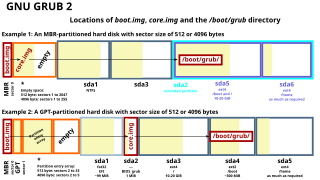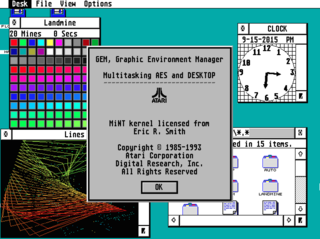Related Research Articles

The Apple II series is a family of home computers, one of the first highly successful mass-produced microcomputer products, designed primarily by Steve Wozniak, manufactured by Apple Computer, and launched in 1977 with the original Apple II.

The Atari ST is a line of personal computers from Atari Corporation and the successor to the Atari 8-bit family. The initial model, the Atari 520ST, had limited release in April–June 1985 and was widely available in July. It was the first personal computer with a bitmapped color GUI, using a version of Digital Research's GEM from February 1985. The Atari 1040ST, released in 1986 with 1 MB of RAM, was the first home computer with a cost-per-kilobyte of less than US$1.
AmigaDOS is the disk operating system of the AmigaOS, which includes file systems, file and directory manipulation, the command-line interface, and file redirection.

A boot sector is the sector of a persistent data storage device which contains machine code to be loaded into random-access memory (RAM) and then executed by a computer system's built-in firmware.
A boot disk is a removable digital data storage medium from which a computer can load and run (boot) an operating system or utility program. The computer must have a built-in program which will load and execute a program from a boot disk meeting certain standards.

A live CD is a complete bootable computer installation including operating system which runs directly from a CD-ROM or similar storage device into a computer's memory, rather than loading from a hard disk drive. A live CD allows users to run an operating system for any purpose without installing it or making any changes to the computer's configuration. Live CDs can run on a computer without secondary storage, such as a hard disk drive, or with a corrupted hard disk drive or file system, allowing data recovery.
The Amiga Fast File System is a file system used on the Amiga personal computer. The previous Amiga filesystem was never given a specific name and known originally simply as "DOS" or AmigaDOS. Upon the release of FFS, the original filesystem became known as Amiga Old File System (OFS). OFS, which was primarily designed for use with floppy disks, had been proving slow to keep up with hard drives of the era. FFS was designed as a full replacement for the original Amiga filesystem. FFS differs from its predecessor mainly in the removal of redundant information. Data blocks contain nothing but data, allowing the filesystem to manage the transfer of large chunks of data directly from the host adapter to the final destination.
Byte Bandit is a boot sector computer virus created for the Amiga personal computer. It first appeared in January 1988.
In computer data storage, a volume or logical drive is a single accessible storage area with a single file system, typically resident on a single partition of a hard disk. Although a volume might be different from a physical disk drive, it can still be accessed with an operating system's logical interface. However, a volume differs from a partition.
Lamer Exterminator is a computer virus created for the Amiga. It was first detected in Germany in October 1989. It is a boot block virus contained in the first 1024 bytes of the disk.
Amiga Disk File (ADF) is a file format used by Amiga computers and emulators to store images of floppy disks. It has been around almost as long as the Amiga itself, although it was not initially called by any particular name. Before it was known as ADF, it was used in commercial game production, backup and disk virtualization. ADF is a track-by-track dump of the disk data as read by the Amiga operating system, and so the "format" is really fixed-width AmigaDOS data tracks appended one after another and held in a file. This file would, typically, be formatted, like the disk, in Amiga Old File System (OFS).
AmigaOS is the proprietary native operating system of the Amiga personal computer. Since its introduction with the launch of the Amiga 1000 in 1985, there have been four major versions and several minor revisions of the operating system.

TOS is the operating system of the Atari ST range of computers. This range includes the 520ST and 1040ST, their STF/M/FM and STE variants and the Mega ST/STE. Later, 32-bit machines were developed using a new version of TOS, called MultiTOS, which allowed multitasking. More recently, users have further developed TOS into FreeMiNT.
Amiga support and maintenance software performs service functions such as formatting media for a specific filesystem, diagnosing failures that occur on formatted media, data recovery after media failure, and installation of new software for the Amiga family of personal computers—as opposed to application software, which performs business, education, and recreation functions.
Kickstart is the bootstrap firmware of the Amiga computers developed by Commodore International. Its purpose is to initialize the Amiga hardware and core components of AmigaOS and then attempt to boot from a bootable volume, such as a floppy disk. Most Amiga models were shipped with the Kickstart firmware stored on ROM chips.

AmigaOS is a family of proprietary native operating systems of the Amiga and AmigaOne personal computers. It was developed first by Commodore International and introduced with the launch of the first Amiga, the Amiga 1000, in 1985. Early versions of AmigaOS required the Motorola 68000 series of 16-bit and 32-bit microprocessors. Later versions were developed by Haage & Partner and then Hyperion Entertainment. A PowerPC microprocessor is required for the most recent release, AmigaOS 4.
The floppy disk is a data storage and transfer medium that was ubiquitous from the mid-1970s well into the 2000s. Besides the 3½-inch and 5¼-inch formats used in IBM PC compatible systems, or the 8-inch format that preceded them, many proprietary floppy disk formats were developed, either using a different disk design or special layout and encoding methods for the data held on the disk.

The IBM Personal Computer XT is the second computer in the IBM Personal Computer line, released on March 8, 1983. Except for the addition of a built-in hard drive and extra expansion slots, it is very similar to the original IBM PC model 5150 from 1981.
ANTI is a computer virus affecting Apple Macintosh computers running classic Mac OS versions up to System 6. It was the first Macintosh virus not to create additional resources within infected files; instead, it patches existing CODE resources.
References
- ↑ Maher, Jimmy (2012-04-13). "The Scene". The Future Was Here: The Commodore Amiga. MIT Press. pp. 171–178. ISBN 978-0-262-30074-2.
- Mark R. Brown (January 1988). "Virus!". Info (18). Info magazine description of the virus